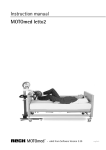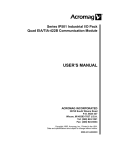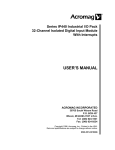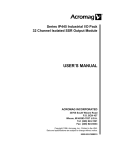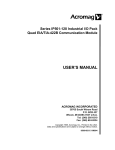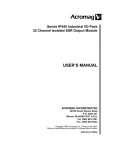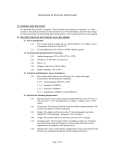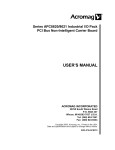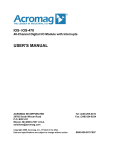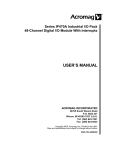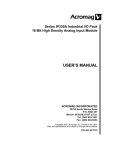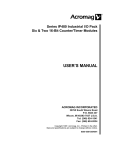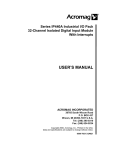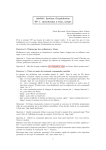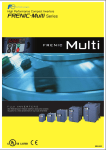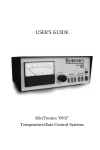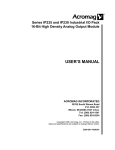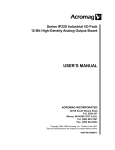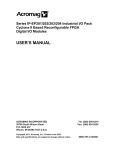Download USER`S MANUAL
Transcript
Series IP502 Industrial I/O Pack Quad EIA RS-485 Serial Communication Module USER’S MANUAL ACROMAG INCORPORATED 30765 South Wixom Road P.O. BOX 437 Wixom, MI 48393-7037 U.S.A. Tel: (248) 624-1541 Fax: (248) 624-9234 Copyright 1995, Acromag, Inc., Printed in the USA. Data and specifications are subject to change without notice. 8500-547-D02A009 SERIES IP502 INDUSTRIAL I/O PACK QUAD EIA RS-485 SERIAL COMMUNICATION MODULE ___________________________________________________________________________________________ The information contained in this manual is subject to change without notice. Acromag, Inc. makes no warranty of any kind with regard to this material, including, but not limited to, the implied warranties of merchantability and fitness for a particular purpose. Further, Acromag, Inc. assumes no responsibility for any errors that may appear in this manual and makes no commitment to update, or keep current, the information contained in this manual. No part of this manual may be copied or reproduced in any form, without the prior written consent of Acromag, Inc. Table of Contents 1.0 GENERAL INFORMATION............................................... KEY IP502 FEATURES..................................................... INDUSTRIAL I/O PACK INTERFACE FEATURES.......... SIGNAL INTERFACE PRODUCTS.................................. INDUSTRIAL I/O PACK SOFTWARE LIBRARY.............. 2.0 PREPARATION FOR USE................................................ UNPACKING AND INSPECTION..................................... CARD CAGE CONSIDERATIONS................................... BOARD CONFIGURATION.............................................. CONNECTORS................................................................. IP Field I/O Connector (P2)............................................ Noise and Grounding Considerations............................. IP Logic Interface Connector (P1).................................. 3.0 PROGRAMMING INFORMATION.................................... ADDRESS MAPS.............................................................. IP Communication & Configuration Registers................ IP Identification PROM................................................... THE EFFECT OF RESET................................................. IP502 PROGRAMMING.................................................... FIFO Polled Mode.......................................................... FIFO Interrupt Mode....................................................... Generating Interrupts..................................................... 4.0 THEORY OF OPERATION............................................... RS-485 SERIAL INTERFACE........................................... IP502 OPERATION........................................................... LOGIC/POWER INTERFACE........................................... 5.0 SERVICE AND REPAIR.................................................... SERVICE AND REPAIR ASSISTANCE........................... PRELIMINARY SERVICE PROCEDURE......................... 6.0 SPECIFICATIONS............................................................. GENERAL SPECIFICATIONS.......................................... RS-485 PORTS................................................................. TRANSCEIVERS.............................................................. INDUSTRIAL I/O PACK COMPLIANCE........................... IMPORTANT SAFETY CONSIDERATIONS It is very important for the user to consider the possible adverse effects of power, wiring, component, sensor, or software failures in designing any type of control or monitoring system. This is especially important where economic property loss or human life is involved. It is important that the user employ satisfactory overall system design. It is agreed between the Buyer and Acromag, that this is the Buyer's responsibility. Page 2 2 3 3 3 4 4 4 4 4 4 5 5 5 5 7 12 12 12 13 13 13 15 15 16 16 16 16 16 17 17 17 17 17 APPENDIX......................................................................... CABLE: MODEL 5025-550. & 5025-551........................... CABLE: MODEL 5029-943................................................ CABLE: MODEL 5029-900................................................ TERMINATION PANEL: MODEL 5025-552..................... TERMINATION PANEL: MODEL 5029-910..................... TRANSITION MODULE: MODEL TRANS-GP................. 18 18 18 18 18 19 19 DRAWINGS 4501-434 IP MECHANICAL ASSEMBLY......................... 4501-556 IP502 COMMUNICATION CABLE.................... 4501-558 IP502 INTERFACE DIAGRAM......................... 4501-559 IP502 TERM/BIAS RESISTOR LOCATION..... 4501-557 IP502 BLOCK DIAGRAM.................................. 4501-462 CABLE 5025-550 (NON-SHIELDED).............. 4501-463 CABLE 5025-551 (SHIELDED)........................ 4501-464 TERMINATION PANEL 5025-552................... 4501-465 TRANSITION MODULE TRANS-GP............... Page 20 21 22 23 24 25 26 27 28 -2- 1.0 GENERAL INFORMATION The Industrial I/O Pack (IP) Series IP502 module provides four asynchronous EIA RS-485 serial communication ports for interfacing to the VMEbus or PC bus. This model includes halfduplex data paths which permits bi-directional data transmission, one direction at a time. Four units may be mounted on a carrier board to provide up to 16 asynchronous serial ports per 6U-VMEbus system slot or ISA bus (PC/AT) system slot. The electrical characteristics of the RS-485 standard specifies transceivers that implement differential data transmission. The use of differential data transmission allows the reliable transmission of data at high rates over up to 4000 meter distances and through noisy environments. Differential transmission nullifies the effects of ground shifts and noise signals which appear as common-mode voltages on the line. Up to 32 network nodes can be connected to each cable segment. This is achieved by using tri-state drivers under program control. Standard protocols (for example polling or token-bus) can be used to ensure only one driver is active at a time. The transmit and receive paths of each channel include generous 16-byte FIFO buffers to minimize CPU interaction. Programmable baud rates up to 512K baud are supported. In addition, character size, stop bits, and parity are software configurable. Prioritized interrupt generation is supported for transmit, and receive line-status. The IP502 utilizes state of the art Surface-Mounted Technology (SMT) to achieve its wide functionality and is an ideal choice for a wide range of industrial communication interface applications that require a highly reliable, high-performance interface at a low cost. KEY IP502 FEATURES • High Density - Provides programmable control of four EIA RS485 asynchronous serial ports. Four units mounted on a carrier board provide 16 serial channels in a single VMEbus or ISA bus (PC/AT) system slot. • 16-Character FIFO Buffers - Both the transmit and receive channels of each serial port provide 16-byte (plus 3 bits per byte) data buffering to reduce CPU interactions and interrupts. • Programmable Character Size - Each serial port is software programmable for 5, 6, 7, or 8 bit character sizes. • Programmable Stop Bits - Each serial port allows 1, 1-1/2, or 2 stop-bits to be added to, or deleted from, the serial data stream. SERIES IP502 INDUSTRIAL I/O PACK QUAD EIA RS-485 SERIAL COMMUNICATION MODULE ___________________________________________________________________________________________ • • • • • • • • • Programmable Parity Generation & Detection - Even, Odd, or No Parity generation and detection is supported. Line-Break Generation & Detection - provision for sending and detecting the line break character is provided. False Start Bit Detection - Prevents the receiver from assembling false data characters due to low-going noise spikes on the RxD input line. Programmable Baud Rate - The internal baud rate generator allows the 8MHz clock to be divided by any divisor between 1 and 2(16-1), providing support for bit rates up to 512Kbps. Interrupt Support - Individually controlled transmit, receive, line status, and data set interrupts may be generated. Unique interrupt vectors may be assigned to each port. Interrupt generation uses a priority shifting scheme based on the last interrupt serviced, preventing the continuous interrupts of one port from freezing out the interrupts of another port. Socketed Termination and Bias Resistors - The network termination and bias resistors are installed in sockets on the board and may be easily inserted or removed where required. Internal Diagnostic Capabilities - Loopback controls for communication link fault isolation are included. Break, parity, overrun, and framing error simulation is also possible. Fail safe Receivers - The receivers employed in this model include a fail safe feature which guarantees a high output state when the inputs are left open or floating. Industry Standard 16550 Family UART w/16C450 Mode The UART of this device is a member of the industry standard 16550 family of UART’s and remains software compatible. Additionally, this device can operate in a 16C450 UART family software compatible mode. The transmit and receive channels are double-buffered in this mode. Hold and shift registers eliminate the need for precise synchronization between the host CPU and the serial data. Cables Model 5025-551-X (Shielded Cable), or Model 5025-550-X (Non-Shielded Cable): A Flat 50-pin cable with female connectors at both ends for connecting AVME9630/9660, or other compatible carrier boards, to Model 5025-552 termination panels. The “-X” suffix of the model number is used to indicate the length in feet. The unshielded cable is recommended for digital I/O, while the shielded cable is recommended for optimum performance with precision analog I/O applications. Model 5029-943 IP500 Serial Communication Cable: A 5 foot long, flat 50-pin cable with a female connector on one end (for connection to AVME9630/9660 or other compatible carrier boards) and four DE-9P connectors (serial ports) on the other end. Also used for interface with Acromag Model IP501 (RS422) & IP502 (RS-485) serial communication modules. Model 5029-900 APC8600 High-Density Cable: A 36-inch long interface cable that mates the high-density (25mil pitch) 50-pin I/O connectors of the APC8600 ISA bus carrier board, to the high-density connectors on the APC8600 Termination Panel (described below). Termination Panels: Model 5025-552: A DIN-rail mountable panel that provides 50 screw terminals for universal field I/O termination. Connects to Acromag AVME9630/9660, or other compatible carrier boards, via flat 50-pin ribbon cable (Model 5025-550-X or 5025-551-X). Model 5029-910 APC8600 High-Density-to-Screw-Terminal Termination Panel: This panel converts the high-density ribboncable connectors coming from the APC8600 carrier board (Acromag cable Model 5029-900) to screw terminals, for directwired interfaces. INDUSTRIAL I/O PACK INTERFACE FEATURES High density - Single-size, industry standard, IP module footprint. Four units mounted on a carrier board provide up to 16 serial ports in a single system slot. Both VMEbus and ISA bus (PC/AT) carriers are supported. • Local ID - Each IP module has its own 8-bit ID PROM which can be read via access to the "ID PROM" space. • 8-bit I/O - Port register Read/Write is performed through 8-bit data transfer cycles in the IP module I/O space. • High Speed - Access times for all data transfer cycles are described in terms of "wait" states - 2 wait states are required for reading and writing channel data and for interrupt select cycles, 1 wait state for reading the ID PROM (see Specifications section for detailed information). • Transition Module: Model TRANS-GP: This module repeats field I/O connections of IP modules A through D for rear exit from a VMEbus card cage. It is available for use in card cages which provide rear exit for I/O connections via transition modules (transition modules can only be used in card cages specifically designed for them). It is a double-height (6U), single-slot module with front panel hardware adhering to the VMEbus mechanical dimensions, except for shorter printed circuit board depth. It connects to Acromag Termination Panel 5025-552 from the rear of the card cage, and to AVME9630/9660 boards within the card cage, via flat 50-pin ribbon cable (cable Model 5025-550-X or 5025-551X). INDUSTRIAL I/O PACK SOFTWARE LIBRARY SIGNAL INTERFACE PRODUCTS (See Appendix for more information on compatible products) Acromag provides an Industrial I/O Pack Software Library diskette (Model IPSW-LIB-M03, MSDOS format) to simplify communication with the board. Example software functions are provided for both VMEbus and ISA bus (PC/AT) applications. All functions are written in the “C” programming language and can be linked to your application. For more details, refer to the “README.TXT” file in the root directory on the diskette and the “INFO502.TXT” file in the appropriate “IP502” subdirectory off of “\VMEIP” or “\PCIP”, according to your carrier. This IP module will mate directly to any industry standard IP carrier board (including Acromag AVME9630/9660 3U/6U nonintelligent VMEbus carrier boards). Additionally, Acromag’s APC8600 ISA bus (PC/AT) carrier board is also supported. A wide range of other Acromag IP modules are also available to serve your signal conditioning and interface needs. The following cables and termination panels are also available. Consult your carrier board documentation for the correct interface product part numbers to ensure compatibility with your carrier board. -3- SERIES IP502 INDUSTRIAL I/O PACK QUAD EIA RS-485 SERIAL COMMUNICATION MODULE ___________________________________________________________________________________________ 2.0 PREPARATION FOR USE IMPORTANT: The IP502 comes with network termination (120Ω) and bias (560Ω) resistors installed in sockets on the board. You need to consider your network application carefully, and remove resistors where appropriate. Termination resistors should only be installed at the ends of the network. Likewise, a network channel only needs one set of bias resistors, usually on the driving end. You should also remove redundant bias resistors where appropriate. Failure to remove termination and bias resistors where required will significantly increase current draw and in some cases, may affect performance. Refer to Drawing 4501-558 and 4501-559 for instructions. UNPACKING AND INSPECTION Upon receipt of this product, Inspect the shipping carton for evidence of mishandling during transit. If the shipping carton is badly damaged or water stained, request that the carrier's agent be present when the carton is opened. If the carrier's agent is absent when the carton is opened and the contents of the carton are damaged, keep the carton and packing material for the agent's inspection. For repairs to a product damaged in shipment, refer to the Acromag Service Policy to obtain return instructions. It is suggested that salvageable shipping cartons and packing material be saved for future use in the event the product must be shipped. CONNECTORS IP Field I/O Connector (P2) P2 provides the field I/O interface connections for mating IP modules to the carrier board. P2 is a 50-pin female receptacle header (AMP 173279-3 or equivalent) which mates to the male connector of the carrier board (AMP 173280-3 or equivalent). This provides excellent connection integrity and utilizes gold-plating in the mating area. Threaded metric M2 screws and spacers are supplied with the module to provide additional stability for harsh environments (see Mechanical Assembly Drawing 4501-434). The field and logic side connectors are keyed to avoid incorrect assembly. P2 pin assignments are unique to each IP model (see Table 2.1) and normally correspond to the pin numbers of the field I/O interface connector on the carrier board (you should verify this for your carrier board). This board is physically protected with packing material and electrically protected with an anti-static bag during shipment. However, it is recommended that the board be visually inspected for evidence of mishandling prior to applying power. The board utilizes static sensitive components and should only be handled at a static-safe workstation. Table 2.1: IP502 Field I/O Pin Connections (P2) Pin Description Number Pin Description COMMON 1 COMMON Not Used 2 Not Used TXRX+_A 3 TXRX+_C Not Used 4 Not Used TXRX-_A 5 TXRX-_C Not Used 6 Not Used TXRX-_A 7 TXRX-_C Not Used 8 Not Used TXRX+_A 9 TXRX+_C COMMON 10 COMMON Not Used 11 Not Used TXRX+_B 12 TXRX+_D Not Used 13 Not Used TXRX-_B 14 TXRX-_D Not Used 15 Not Used TXRX-_B 16 TXRX-_D Not Used 17 Not Used TXRX+_B 18 TXRX+_D COMMON 19 COMMON COMMON 20 COMMON COMMON 21 COMMON COMMON 22 COMMON COMMON 23 COMMON COMMON 24 COMMON COMMON 25 COMMON CARD CAGE CONSIDERATIONS Refer to the specifications for loading and power requirements. Be sure that the system power supplies are able to accommodate the power requirements of the carrier board, plus the installed IP modules, within the voltage tolerances specified. IMPORTANT: Adequate air circulation must be provided to prevent a temperature rise above the maximum operating temperature. The dense packing of the IP modules to the carrier board restricts air flow within the card cage and is cause for concern. Adequate air circulation must be provided to prevent a temperature rise above the maximum operating temperature and to prolong the life of the electronics. If the installation is in an industrial environment and the board is exposed to environmental air, careful consideration should be given to air-filtering. BOARD CONFIGURATION Remove power from the board when installing IP modules, cables, termination panels, and field wiring. Refer to Mechanical Assembly Drawing 4501-434 and your IP module documentation for configuration and assembly instructions. Model IP502 communication boards have no hardware jumpers or switches to configure. However, network termination and bias resistor SIP’s are installed in sockets on the board and can be easily removed where required (refer to Drawing 4501-558 & 4501-559). An Asterisk (*) is used to indicate an active-low signal. -4- Number 26 27 28 29 30 31 32 33 34 35 36 37 38 39 40 41 42 43 44 45 46 47 48 49 50 SERIES IP502 INDUSTRIAL I/O PACK QUAD EIA RS-485 SERIAL COMMUNICATION MODULE ___________________________________________________________________________________________ Keep them away from power and other wiring to avoid noise-coupling and crosstalk interference. EIA RS-485 communication distances are generally limited to less than 4000 feet. Always keep interface cabling and ground wiring as short as possible for best performance. Please refer to Drawing 4501-556 for example connections and proper grounding practices. Note that the pin-wire assignments are arranged such that IDC D-SUB ribbon cable connectors can be conveniently attached to provide serial port A (pins 1-9), serial port B (pins 10-18), serial port C (pins 26-34), & serial port D (pins 35-43) connectivity. Plus (+) and minus (-) following the signal name indicate differential signal polarity. In Table 2.1, a suffix of “_A”, “_B”, “_C”, or “_D” is appended to each pin label to denote its port association. A brief description of each of the serial port signals at P2 is included next. A complete functional description of the P2 pin functions is included in Section 4.0 (Theory Of Operation). Be careful not to confuse the four RS485 ports A-D of the IP502 module with the carrier board’s four IP module slots A-D. IP Logic Interface Connector (P1) P1 of the IP module provides the logic interface to the mating connector on the carrier board. This connector is a 50-pin female receptacle header (AMP 173279-3 or equivalent) which mates to the male connector of the carrier board (AMP 173280-3 or equivalent). This provides excellent connection integrity and utilizes gold-plating in the mating area. Threaded metric M2 screws and spacers are supplied with the IP module to provide additional stability for harsh environments (see Drawing 4501-434 for assembly details). Field and logic side connectors are keyed to avoid incorrect assembly. The pin assignments of P1 are standard for all IP modules according to the Industrial I/O Pack Specification (see Table 2.3). Table 2.2: P2 Pin Signal Descriptions SIGNAL DESCRIPTION TXRX+_A Transmit Data Line Output and Receive Data Line TXRX+_B Input +. To the communication network master this TXRX+_C line is used as the + transmit data line. To the TXRX+_D communication network slaves this line is used as the + receive data line. Transmit Data Line Output and Receive Data Line TXRX-_A Input -. To the communication network master this TXRX-_B line is used as the - transmit data line. To the TXRX-_C communication network slaves this line is used as TXRX-_D the - receive data line. Table 2.3: Standard Logic Interface Connections (P1) Pin Description GND CLK Reset* D00 D01 D02 D03 D04 D05 D06 D07 D08 D09 D10 D11 D12 D13 D14 D15 BS0* BS1* -12V +12V +5V GND Note that not all UART signal paths are used by this model and their corresponding UART pins are tied high (+5V). This includes, RI (Ring Indicator), CTS (Clear To Send), DSR (Data Set Ready), and DCD (Data Carrier Detect). In addition, the UART RTS (Ready To Send) signal active while DTR (Data Terminal Ready) signal inactive enables the transceivers to transmit data. As shown in the table below, RTS and DTR in any other state enables the transceiver to receive data. RTS Inactive Inactive Active Active DTR Inactive Active Inactive Active Transceiver Mode Receive Receive Transmit Receive Noise and Grounding Considerations The serial channels of this module are non-isolated and share a common signal ground connection. Further, the IP502 is nonisolated between the logic and field I/O grounds since signal common is electrically connected to the IP module ground. Consequently, the field interface connections are not isolated from the carrier board and backplane. Care should be taken in designing installations without isolation to avoid noise pickup and ground loops caused by multiple ground connections. Number 1 2 3 4 5 6 7 8 9 10 11 12 13 14 15 16 17 18 19 20 21 22 23 24 25 Pin Description GND +5V R/W* IDSEL* DMAReq0* MEMSEL* DMAReq1* IntSel* DMAck0* IOSEL* RESERVED A1 DMAEnd* A2 ERROR* A3 INTReq0* A4 INTReq1* A5 STROBE* A6 ACK* RESERVED GND Number 26 27 28 29 30 31 32 33 34 35 36 37 38 39 40 41 42 43 44 45 46 47 48 49 50 An Asterisk (*) is used to indicate an active-low signal. BOLD ITALIC Logic Lines are NOT USED by this IP Model. The signal ground connection at the communication ports are common to the IP interface ground, which is typically common to safety (chassis) ground when mounted on a carrier board and inserted in a backplane. As such, be careful not to attach signal ground to safety ground via any device connected to these ports, or a ground loop will be produced, and this may adversely affect operation. 3.0 PROGRAMMING INFORMATION ADDRESS MAPS This board is addressable in the Industrial Pack I/O space to control the interface configuration, data transfer, and steering logic of four EIA RS-485 serial ports. As such, three types of information are stored in the I/O space: control, status, and data. These registers are listed below along with their mnemonics used throughout this manual. The communication cabling of the P2 interface carries digital data at a high transfer rate. For best performance, increased signal integrity, and safety reasons, you should isolate these connections. -5- SERIES IP502 INDUSTRIAL I/O PACK QUAD EIA RS-485 SERIAL COMMUNICATION MODULE ___________________________________________________________________________________________ Serial Port A Registers: Base MSB LSB LCR Addr+ D15 D08 D07 D00 Bit7 READ - IIR 04 Port A Interrupt Not Driven1 Identification Register WRITE - FCR 04 Not Driven1 Port A FIFO Control Register R/W - LCR 06 Not Driven1 Port A Line Control Register R/W - MCR 08 Not Driven1 Port A Modem Control Register R/W - LSR 0A Not Driven1 Port A Line Status Register R/W - MSR 0C Not Driven1 Port A Modem Status Register R/W - SCR 0E Not Driven1 Port A Scratch Pad/Interrupt Vector Register SERIAL DATA REGISTERS (Per Serial Port): RBR Receive Buffer Register THR Transmitter Holding Register SERIAL STATUS REGISTERS (Per Serial Port): LSR Line Status Register MSR Modem Status Register SERIAL CONTROL REGISTERS (Per Serial Port): LCR Line Control Register FCR FIFO Control Register MCR Modem Control Register DLL Divisor Latch LSB DLM Divisor Latch MSB IER Interrupt Enable Register SCR Scratchpad/Interrupt Vector Register The I/O space may be as large as 64, 16-bit words (128 bytes) using address lines A1..A6, but the IP502 uses only a portion of this space. The I/O space address map for the IP502 is shown in Table 3.1. Note the base address for the IP module I/O space (see your carrier board instructions) must be added to the addresses shown to properly access the I/O space. All accesses are to the low byte on an 8-bit word basis (D0..D7). Table 3.1B: IP502 I/O Space Memory Map...continued Serial Port B Registers: Base MSB LSB LCR Addr+ D15 D08 D07 D00 Bit7 READ - RBR 10 Not Driven1 Port B Receiver 0 Buffer Register This module supports byte accesses using the “Big Endian” byte ordering format. Big Endian is the convention used in the Motorola 68000 microprocessor family and is the VMEbus convention. In Big Endian, the lower-order byte is stored at odd-byte addresses. The Intel x86 family of microprocessors use the opposite convention, or “Little Endian” byte ordering. Little Endian uses even-byte addresses to store the low-order byte. As such, use of this module on a PC carrier board will require the use of the even address locations to access the lower 8-bit data while on a VMEbus carrier use of odd address locations are required to access the lower 8-bit data. 10 10 12 Note that some functions share the same register address. For these items, the address lines are used along with the divisor latch access bit (bit 7 of the Line Control Register) and/or the read and write signals to determine the function required. Beyond the first two address locations for each serial port, the state of the divisor latch access bit is irrelevant. 12 Not Driven1 WRITE - THR Port B Transmitter Holding Register 0 Not Driven1 R/W - DLL Port B Divisor Latch LSB 1 Not Driven1 R/W - IER Port B Interrupt Enable Register 0 R/W - DLM Port B Divisor Latch MSB 1 1 Not Driven 14 Table 3.1A: IP502 I/O Space Address (Hex) Memory Map Serial Port A Registers: Base MSB LSB LCR Base Addr+ D15 D08 D07 D00 Bit7 Addr+ READ - RBR 00 Not Driven1 Port A Receiver 0 Buffer Register 01 WRITE - THR 00 1 Not Driven Port A Transmitter 0 Holding Register 01 R/W - DLL 00 1 Not Driven Port A Divisor Latch 1 LSB 01 R/W - IER 02 Not Driven1 Port A Interrupt 0 Enable Register 03 R/W - DLM 02 Not Driven1 Port A Divisor Latch 1 MSB 03 14 Not Driven1 1 Not Driven 16 1 Not Driven 18 1A 1C Not Driven1 Not Driven1 1 Not Driven 1E -6- Not Driven1 Base Addr+ 05 05 07 09 0B 0D 0F Base Addr+ 11 11 11 13 READ - IIR Port B Interrupt Identification Register WRITE - FCR Port B FIFO Control Register R/W - LCR Port B Line Control Register R/W - MCR Port B Modem Control Register R/W - LSR Port B Line Status Register R/W - MSR Port B Modem Status Register R/W - SCR Port B Scratch Pad/Interrupt Vector Register 13 15 15 17 19 1B 1D 1F SERIES IP502 INDUSTRIAL I/O PACK QUAD EIA RS-485 SERIAL COMMUNICATION MODULE ___________________________________________________________________________________________ Table 3.1C: IP502 I/O Space Memory Map...continued Serial Port C Registers: Base MSB LSB LCR Addr+ D15 D08 D07 D00 Bit7 READ - RBR 20 Not Driven1 Port C Receiver 0 Buffer Register WRITE - THR 20 Not Driven1 Port C Transmitter 0 Holding Register R/W - DLL 20 Not Driven1 Port C Divisor Latch 1 LSB R/W - IER 22 Not Driven1 Port C Interrupt 0 Enable Register R/W - DLM 22 Not Driven1 Port C Divisor Latch 1 MSB READ - IIR 24 Not Driven1 Port C Interrupt Identification Register WRITE - FCR 24 Not Driven1 Port C FIFO Control Register R/W - LCR 26 Not Driven1 Port C Line Control Register R/W - MCR 28 Not Driven1 Port C Modem Control Register R/W - LSR 2A Not Driven1 Port C Line Status Register R/W - MSR 2C Not Driven1 Port C Modem Status Register R/W - SCR 2E Not Driven1 Port C Scratch Pad/ Interrupt Vector Register Table 3.1D: IP502 I/O Space Memory Map...continued Serial Port D Registers: Base MSB LSB LCR Addr+ D15 D08 D07 D00 Bit7 READ - RBR 30 Not Driven1 Port D Receiver 0 Buffer Register WRITE - THR 30 Not Driven1 Port D Transmitter 0 Holding Register R/W - DLL 30 Not Driven1 Port D Divisor Latch 1 LSB R/W - IER 32 Not Driven1 Port D Interrupt 0 Enable Register R/W - DLM 32 Not Driven1 Port D Divisor Latch 1 MSB READ - IIR 34 Not Driven1 Port D Interrupt Identification Register WRITE - FCR 34 Not Driven1 Port D FIFO Control Register R/W - LCR 36 Not Driven1 Port D Line Control Register R/W - MCR 38 Not Driven1 Port D Modem Control Register R/W - LSR 3A Not Driven1 Port D Line Status Register R/W - MSR 3C Not Driven1 Port D Modem Status Register R/W - SCR 3E Not Driven1 Port D Scratch Pad/ Interrupt Vector Register 40 NOT USED2 ↓ 7E Base Addr+ 21 21 21 23 23 25 25 27 29 2B 2D 2F This board operates in two different modes. In one mode, this device remains software compatible with the industry standard 16C450 family of UART’s and provides double-buffering of data registers. In the FIFO Mode (enabled via bit 0 of the FCR register), data registers are FIFO-buffered so that read and write operations can be performed while the UART is performing serial-to-parallel and parallel-to-serial conversions. Two FIFO modes are possible: FIFO Interrupt Mode and FIFO Polled Mode. Some registers operate differently between the available modes and this is noted in the following paragraphs. Base Addr+ 31 31 31 33 33 35 35 37 39 3B 3D 3F 41 ↓ 7F Notes (Table 3.1A, B, C, and D): 1. The upper 8 bits of these registers are not driven. Pullups on the carrier board data bus cause these bits to read high (1’s). 2. The IP will not respond to addresses that are "Not Used". 3. All Reads and writes are 2 wait states (except ID PROM reads which are 1 wait state). RBR - Receiver Buffer Register, Ports A-D (READ Only) The Receiver Buffer Register (RBR) is a serial port input data register that receives the input data from the receiver shift register and holds from 5 to 8 bits of data, as specified by the character size programmed in the Line Control Register (LCR bits 0 & 1). If less than 8 bits are transmitted, then data is right-justified to the LSB. If parity is used, then LCR bit 3 (parity enable) and LCR bit 4 (type of parity) are required. Status for the receiver is provided via the LineStatus Register (LSR). When a full character is received (including parity and stop bits), the data-received indication bit 0 of the LSR is set to 1. The host CPU then reads the RBR, which resets LSR bit 0 low. If the character is not read prior to a new character transfer between the receiver shift register and the RBR, the overrun-error status indication is set in LSR bit 1. If there is a parity error, the error is indicated in LSR bit 2. If a stop bit is not detected, a framing error indication is set in bit 3 of the LSR. -7- SERIES IP502 INDUSTRIAL I/O PACK QUAD EIA RS-485 SERIAL COMMUNICATION MODULE ___________________________________________________________________________________________ Table 3.2: Baud Rate Divisors and Relative Error (8MHz Clk) BAUD RATE DIVISOR (N) USED % ERROR DIFF BET DESIRED FOR 16x CLOCK DESIRED & ACTUAL 50 10000 2710H 0 75 6667 1A06H 0.005 110 4545 11C1H 0.010 134.5 3717 0E85H 0.013 150 3333 0D05H 0.010 300 1667 0683H 0.020 600 833 0341H 0.040 1200 417 01A1H 0.080 1800 277 0115H 0.080 2000 250 00FAH 0 2400 208 00D0H 0.160 3600 139 0086H 0.080 4800 104 0068H 0.160 7200 69 0045H 0.644 9600 52 0034H 0.160 19200 26 001AH 0.160 38400 13 000DH 0.160 56000 9 0009H 0.790 128000 4 0004H 2.344 256000 2 0002H 2.344 512000 1 0001H 2.400 Serial asynchronous data is input to the receiver shift register via the receive data line (RxD). From the idle state, this line is monitored for a high-to-low transition (start bit). When the start bit is detected, a counter is reset and counts the 16x clock to 7-1/2 (which is the center of the start bit). The start bit is judged valid if RxD is still low at this point. This is known as false start-bit detection. By verifying the start bit in this manner, it helps to prevent the receiver from assembling an invalid data character due to a low-going noise spike on RxD. If the data on RxD is a symmetrical square wave, the center of the data cells will occur within ±3.125% of the actual center (providing an error margin of 46.875%). Thus, the start bit can begin as much as one 16x clock cycle prior to being detected. THR - Transmitter Holding Register, Ports A-D (WRITE Only) The Transmitter Holding Register (THR) is a serial port output data register that holds from 5 to 8 bits of data, as specified by the character size programmed in the Line Control Register. If less than 8 bits are transmitted, then data is entered right-justified to the LSB. This data is framed as required, then shifted to the transmit data line (TxD). In the idle state, TxD is held high. In Loopback Mode, this data is looped back into the Receiver Buffer Register. DLL & DLM - Divisor Latch Registers, Ports A-D (R/W) With respect to this device, the baud rate may be considered equal to the number of bits transmitted per second (bps). The bit rate (bps), or baud rate, defines the bit time. This is the length of time a bit will be held on before the next bit is transmitted. A receiver and transmitter must be communicating at the same bit rate, or data will be garbled. A receiver is alerted to an incoming character by the start bit, which marks the beginning of the character. It then times the incoming signal, sampling each bit as near to the center of the bit time as possible. The Divisor Latch Registers form the divisor used by the internal baud-rate generator to divide the 8MHz system clock to produce an internal sampling clock suitable for synchronization to the desired baud rate. The output of the baud generator (RCLK) is sixteen times the baud rate. Two 8-bit divisor latch registers per port are used to store the divisors in 16-bit binary format. The DLL register stores the low-order byte of the divisor, DLM stores the high-order byte. These registers must be loaded during initialization. Note that bit 7 of the LCR register must first be set high to access the divisor latch registers (DLL & DLM) during a read/write operation. To better understand the asynchronous timing used by this device, note that the receive data line (RxD) is monitored for a highto-low transition (start bit). When the start bit is detected, a counter is reset and counts the 16x sampling clock to 7-1/2 (which is the center of the start bit). The receiver then counts from 0 to 15 to sample the next bit near its center. This continues until a stop bit is detected which signals the end of the data stream. Use of a sampling rate 16x the baud rate reduces the synchronization error that builds up in estimating the center of each successive bit following the start bit. As such, if the data on RxD is a symmetrical square wave, the center of each successive data cell will occur within ±3.125% of the actual center (this is 50% ÷ 16, providing an error margin of 46.875%). Thus, the start bit can begin as much as one 16x clock cycle prior to being detected. Upon loading either latch, a 16-bit baud counter is immediately loaded (this prevents long counts on initial load). The clock may be divided by any divisor from 1 to 2(16-1). The output frequency of the baud rate generator (RCLK) is 16x the data rate. The relationship between the output of the baud generator (RCLK), the baud rate, the divisor, and the 8MHz system clock can be summarized in the following equations: DIVISOR = CLOCK FREQUENCY ÷ [BAUD RATE x 16]; RCLK = 16 x BAUD RATE; = 16 x [CLOCK ÷ (16 x DIVISOR)] = CLOCK ÷ DIVISOR IER - Interrupt Enable Register, Ports A-D (R/W) The following table shows the correct divisor to use for generation of some standard baud rates (based on the 8MHz clock). Note that baud rates up to 512K may be configured. Provisions for installation of an external crystal has been provided on the circuit board (16MHz). With the 16MHz crystal higher baud rates are possible--you may contact Acromag Applications Engineering to explore options in this area. The Interrupt Enable Register is used to independently enable/ disable the four possible serial channel interrupt sources that drive the INTREQ0* line (Ports A-D share this line). Interrupts are disabled by resetting the corresponding IER bit low (0), and enabled by setting the IER bit high (1). Disabling the interrupt system (IER bits 0-3 low) also inhibits the Interrupt Identification Register (IIR) and the interrupt request line (INTREQ0*). All other functions operate in their normal manner, including the setting of the Line Status Register (LSR) and the Modem Status Register (MSR). Enabling modem interrupts for the IP502 will have no effect since modem interrupts are triggered off CTS* which is not used. -8- SERIES IP502 INDUSTRIAL I/O PACK QUAD EIA RS-485 SERIAL COMMUNICATION MODULE ___________________________________________________________________________________________ Bits 4 and 5 of this register are always set to 0. Bits 6 and 7 are set when bit 0 of the FIFO Control Register is set to 1. A power-up or system reset sets IIR bit 0 to 1, bits 1,2,3,6, and 7 to 0, while bits 4 & 5 are permanently low. Interrupt Enable Register IER BIT INTERRUPT ACTION 0 Received Data Available Interrupt Enable and Time-Out Interrupt (FIFO Mode) Enable 1 Transmitter Holding Register Empty Interrupt Enable 2 Receiver Line Status Interrupt Enable 3 Modem Status Interrupt Enable 4-7 Not Used - Set to Logic 0 FCR - FIFO Control Register, Ports A-D (WRITE Only) This write-only register is used to enable and clear the FIFO buffers, set the trigger level of the Rx FIFO, and select the type of DMA signaling (DMA is NOT supported by this model). A power-up or system reset sets all IER bits to 0 (bits 0-3 forced low, bits 4-7 permanently low). A power-up or system reset sets all FCR bits to 0. IIR - Interrupt Identification Register, Ports A-D (READ Only) FIFO Control Register FCR BIT FUNCTION 0 When set to “1”, this bit enables both the Tx and Rx FIFO’s. All bytes in both FIFO’s can be cleared by resetting this bit to 0. Data is cleared automatically from the FIFO’s when changing from FIFO mode to the alternate (16C450) mode and visa-versa. Programming of other FCR bits is enabled by setting this bit to 1. 1 When set to “1”, this bit clears all bytes in the RxFIFO and resets the counter logic to 0 (this does not clear the shift register). 2 When set to “1”, this bit clears all bytes in the TxFIFO and resets the counter logic to 0 (this does not clear the shift register). 3 When set to “1”, this bit sets DMA Signal from Mode 0 to Mode 1, if FIFO Control Register Bit 0 = 1 (DMA Not Supported) 4,5 Not Used 6,7 Used for setting the trigger level of the Rx FIFO interrupt as follows: The Interrupt Identification Register is used to indicate that a prioritized interrupt is pending and the type of interrupt that is pending. This register will indicate the highest-priority type of interrupt pending for the channel. Individual serial channels prioritize their interrupts into four levels (indicated below). This helps minimize software overhead during data character transfers. Additionally, with respect to the four channels sharing INTREQ0, interrupts are served according to a shifting priority scheme that is a function of the last port served. Modem interrupts are not possible with the IP502 since the CTS* handshake line is not used. PRIORITY/LEVEL INTERRUPT 1 Receiver Line Status 2 Received Data Ready or Character Time-out 3 Transmitter Holding Register Empty 4 Modem Status The four lower order bits of this register are used to identify the interrupt pending as follows: Interrupt Identification Register BITS INT INTERR. INTERRUPT 3-0 TYPE SOURCE PRTY 0001 -None None 0110 1st Receiver OE, PE, FE, or Line Status BI (See LSR Bits 1-4) 0100 2nd Received Receiver Data Data Available or Available Trigger Level Reached 1100 2nd Character No characters Time-out have been Indication removed from or input to the Rx FIFO during last 4 character times and there is at least 1 character in it during this time 0010 3rd THRE THRE (LSR Bit 5) (LSR Bit 5) 0000 4th Modem Status CTS* not used. Modem interrupts are not supported BIT 7-6 00 01 10 11 RESET CONTROL -LSR Read RBR Read till FIFO below trigger level Rx-FIFO TRIGGER LEVEL 01 Bytes 04 Bytes 08 Bytes 14 Bytes MCR - Modem Control Register, Ports A-D (R/W) The Modem Control register controls the interface with the modem or data set as described below. For this model, handshake lines are not supported. The RTS output is directly controlled by its control bit in this register (a high input asserts these signals) and is used to enable the transceiver for data output. RBR Read IIR Read (if LSR bit 5 is the interrupt source) or a THR Write MSR Read -9- SERIES IP502 INDUSTRIAL I/O PACK QUAD EIA RS-485 SERIAL COMMUNICATION MODULE ___________________________________________________________________________________________ Modem Status Register MSR BIT FUNCTION 0 ∆CTS - NOT SUPPORTED 1 ∆DSR - NOT SUPPORTED 2 ∆RI - NOT SUPPORTED 3 ∆DCD - NOT SUPPORTED 4 CTS - If the channel is in the loopback mode (MCR bit 4 = 1), then the state of RTS in the MCR is reflected 5 DSR - NOT SUPPORTED 6 RI - NOT SUPPORTED 7 DCD - NOT SUPPORTED Modem Control Register MCR FUNCTION PROGRAMMING Bit 0=DTR* Not Asserted (Inactive) 0 Data 1=DTR* Asserted (Active). Terminal A DTR signal path is NOT SUPPORTED Ready by this model. Instead, this output is Output used to enable the transceivers for data Signal input. DTR active enables data receive (DTR) mode. 0=RTS* Not Asserted (Inactive) 1 Request to 1=RTS* Asserted (Active) Send A RTS signal path is NOT SUPPORTED Output by this model. Instead, this output is Signal used to enable the transceivers for data (RTS) output. RTS active enables data transmit mode. 2 Out1 No Effect on External Operation (Internal) 0=External Serial Channel Interrupt 3 Out2 Disabled (Internal) 1=External Serial Channel Interrupt Enabled 4 5,6,7 Loop1 Not Used Note that reading MSR clears the delta-modem status indication (bits 0), but has no effect on the other status bits. For both the LSR & MSR, the setting of the status bit during a status register read operation is inhibited (the status bit will not be set until the trailing edge of the read). However, if the same status condition occurs during a read operation, that status bit is cleared on the trailing edge of the read instead of being set again. A power-up or system reset sets MSR bit 0 to 0 (bit 4 is determined by input signal). Unused bits are always clear. 0=Loop Disabled 1=Loop Enabled Bits are set to logic 0 LSR - Line Status Register, Ports A-D (Read/Write-Restricted) The Line Status Register (LSR) provides status indication corresponding to the data transfer. LSR bits 1-4 are the error conditions that produce receiver line-status interrupts (a priority 1 interrupt in the Interrupt Identification Register). The line status register may be written, but this is intended for factory test and should be considered read-only by the applications software. Notes (Modem Control Register): 1. MCR Bit 4 provides a local loopback feature for diagnostic testing of the UART channel. When set high, the UART serial output (connected to the TXD driver) is set to the marking (logic 1 state), and the UART receiver serial data input is disconnected from the RxD receiver path. The output of the UART transmitter shift register is then looped back into the receiver shift register input. The four modem control inputs (CTS, DSR, DCD, and RI) are disconnected from their receiver input paths. The four modem control outputs (DTR, RTS, OUT1, and OUT2) are internally connected to the four modem control inputs (while their associated pins are forced to their high/ inactive state). Thus, in the loopback diagnostic mode, transmitted data is immediately received permitting the host processor to verify the transmit and receive data paths of the selected serial channel. In this mode, interrupts are generated by controlling the state of the four lower order MCR bits internally, instead of by the external hardware paths. However, no interrupt request or interrupt vectors are actually served in loopback mode, and interrupt pending status is only reflected internally. Line Status Register LSR FUNCTION Bit 0 Data Ready (DR) 1 Overrun Error (OE) 2 Parity Error (PE) A power-up or system reset sets all MCR bits to 0 (bits 5-7 are permanently low). MSR - Modem Status Register, Ports A-D (Read/Write) The Modem Status Register (MSR) provides the host CPU with an indication on the status of the modem input lines from a modem or other peripheral device. This model does not provide support for handshake lines. - 10 - PROGRAMMING 0=Not Ready (reset low by CPU Read of RBR or FIFO). 1=Data Ready (set high when character received and transferred into the RBR or FIFO). 0=No Error 1=Indicates that data in the RBR is not being read before the next character is transferred into the RBR, overwriting the previous character. In the FIFO mode, it is set after the FIFO is filled and the next character is received. The overrun error is detected by the CPU on the first LSR read after it happens. The character in the shift register is not transferred into the FIFO, but is overwritten. This bit is reset low when the CPU reads the LSR. 0=No Error 1=Parity Error - the received character does not have the correct parity as configured via LCR bits 3 & 4. This bit is set high on detection of a parity error and reset low when the host CPU reads the contents of the LSR. In the FIFO mode, the parity error is associated with a particular character in the FIFO (LSR Bit 2 reflects the error when the character is at the top of the FIFO). SERIES IP502 INDUSTRIAL I/O PACK QUAD EIA RS-485 SERIAL COMMUNICATION MODULE ___________________________________________________________________________________________ LSR Bit 3 4 5 FUNCTION PROGRAMMING Framing Error (FE) 0=No Error 1=Framing Error - Indicates that the received character does not have a valid stop bit (stop bit following last data bit or parity bit detected as a zero/space bit). This bit is reset low when the CPU reads the contents of the LSR. In FIFO mode, the framing error is associated with a particular character in the FIFO (LSR Bit 3 reflects the error when the character is at the top of the FIFO). Break Interrupt (BI) Transmitter Holding Register Empty (THRE) Note that LSR Bits 1-4 (OE, PE, FE, BI) are the error conditions that produce a receiver-line-status interrupt (a priority 1 interrupt in the IIR register when any one of these conditions are detected). This interrupt is enabled by setting IER bit 2 to 1. A power-up or system reset sets all LSR bits to 0, except bits 5 and 6 which are high. LCR - Line Control Register, Ports A-D (Read/Write) The individual bits of this register control the format of the data character as follows: 0=No Break 1=Break - the received data input has been held in the space (logic 0) state for more than a full-word transmission time (start bits + data + parity bit + stop bits). Reset upon read of LSR. In FIFO mode, this bit is associated with a particular character in the FIFO and reflects the Break Interrupt when the break character is at the top of the FIFO. It is detected by the host CPU during the first LSR read. Only one “0” character is loaded into the FIFO when BI occurs. Line Control Register LCR FUNCTION Bit 1 Word and Length 0 Select 0=Not Empty 1=Empty - indicates that the channel is ready to accept a new character for transmission. Set high when character is transferred from the THR into the transmitter shift register. Reset low by loading the THR (It is not reset by a host CPU read of the LSR). In FIFO mode, this bit is set when the Tx FIFO is empty and cleared when one byte is written to the Tx FIFO. When a Transmitter Holding Register Empty interrupt is enabled by IER bit 1, this signal causes a priority 3 interrupt in the IIR. If the IIR indicates that this signal is causing the interrupt, the interrupt is cleared by a read of the IIR. 6 Transmitter Empty (TEMT) 0=Not Empty 1=Transmitter Empty - set when both the Transmitter Holding Register (THR) and the Transmitter Shift Register (TSR) are both empty. Reset low when a character is loaded into the THR and remains low until the character is transmitted (it is not reset low by a read of the LSR). In FIFO mode, this bit is set when both the transmitter FIFO and shift register are empty. 7 Receiver FIFO Error 0=No Error in FIFO (it is always 0 in the 16C450 mode--FCR bit 0 low). 1=Error in FIFO - set when one of the following data errors is present in the FIFO: parity error, framing error, or break interrupt indication. Cleared by a host CPU read of the LSR if there are no subsequent errors in the FIFO. - 11 - PROGRAMMING 0 0 = 5 Data Bits 0 1 = 6 Data Bits 1 0 = 7 Data Bits 1 1 = 8 Data Bits 0=1 Stop Bit 1=1.5 Stop Bits if 5 data bits selected; 2 Stop Bits if 6, 7, or 8 data bits selected. 2 Stop Bit Select 3 Parity Enable 0=Parity Disabled 1=Parity Enabled-A parity bit is generated and checked for between the last data word bit and the stop bit. 4 Even-Parity Select 0=Odd Parity 1=Even Parity 5 Stick Parity 0=Stick Parity Disabled 1=Stick Parity Enabled-When parity is enabled, stick parity causes the transmission and reception of a parity bit to be in the opposite state from the value selected via bit 4. This is used as a diagnostic tool to force parity to a known state and allow the receiver to check the parity bit in a known state. 6 Break Control 7 Divisor Latch Access Bit 0= Break Disabled 1= Break Enabled-When break is enabled, the serial output line (TxD) is forced to the space state (low). This bit acts only on the serial output and does not affect transmitter logic. For example, if the following sequence is used, no invalid characters are transmitted due to the presence of the break. 1. Load a zero byte in response to the Transmitter Holding Register Empty (THRE) status indication. 2. Set the break in response to the next THRE status indication. 3. Wait for the transmitter to become idle when the Transmitter Empty status signal is set high (TEMT=1); then clear the break when normal transmission has to be restored. 0=Access Receiver Buffer 1=Allow Access to Divisor Latches SERIES IP502 INDUSTRIAL I/O PACK QUAD EIA RS-485 SERIAL COMMUNICATION MODULE ___________________________________________________________________________________________ Note that bit 7 must be set high to access the divisor latch registers DLL & DLM of the baud rate generator during a read/write operation. Bit 7 must be low to access the receiver-buffer register (RBR), the Transmitter-Holding Register (THR), or the InterruptEnable Register (IER). A power-up or system reset sets all LCR bits to 0. A detailed discussion of word length, stop bits, parity, and the break signal is included in Section 4.0, Theory of Operation. THE EFFECT OF RESET A software or hardware reset puts the serial channels into an idle-mode until initialization (programming). A reset initializes the receiver and transmitter clock counters. It also clears the LineStatus Register (LSR), except for the transmitter shift-register empty (TEMT) and transmit holding-register empty (THRE) bits which are set to 1 (note that when interrupts are subsequently enabled, an interrupt will occur due to THRE being set). The Modem Control Register (MCR) and the Transmitter Enable Always Register (TEA) are also cleared. All of the discrete signal lines, memory elements, and miscellaneous logic associated with these register bits are cleared, de-asserted, or turned off. However, the Line Control Register (LCR), divisor latches, Receiver Buffer Register (RBR), and Transmitter Holding Register (THR) are not affected. The following table summarizes the effect of a reset on the various registers and internal and external signals: SCR - Scratch Pad/Interrupt Pointer Register, Ports A-D (R/W) This 8-bit read/write register has no effect on the operation of either serial channel. It is provided as an aide to the programmer to temporarily hold data. Alternately, if interrupt generation is desired, then this port is used to store the interrupt vector for the port. In response to an interrupt select cycle, the IP module will execute a read of this register for the interrupting port (see Interrupt Generation section for more details). The Effect of Reset REGISTER/ RESET SIGNAL CONTROL REGISTERS: IER Reset IP Identification PROM - (Read Only, 32 Odd-Byte Addresses) Each IP module contains an identification (ID) PROM that resides in the ID space per the IP module specification. This area of memory contains 32 bytes of information at most. Both fixed and variable information may be present within the ID PROM. Fixed information includes the "IPAC" identifier, model number, and manufacturer's identification codes. Variable information includes unique information required for the module. The IP502 ID PROM does not contain any variable (e.g. unique calibration) information. ID PROM bytes are addressed using only the odd addresses in a 64 byte block (on the “Big Endian” VMEbus). Even addresses are used on the “Little Endian” PC ISA bus. The IP502 ID PROM contents are shown in Table 3.2. Note that the base-address for the IP module ID space (see your carrier board instructions) must be added to the addresses shown to properly access the ID PROM. Execution of an ID PROM Read requires 1 wait state. STATE/EFFECT All Bits low (Bits 0-3 low, Bits 4-7 permanently low) IIR Reset Bit 0 high, Bits 1,2,3,6,7 low, Bits 4 & 5 permanently low LCR Reset All bits low MCR Reset All bits low (bits 5-7 permanently low) FCR Reset All bits low LSR Reset All bits low, except bits 5 & 6 are high MSR Reset Bits 0-3 low, bits 4-7 per corresponding input signal SIGNALS (INTERNAL & EXTERNAL): TxD Reset High Interrupt (RCVR Read LSR/ Low errors) Reset Low Interrupt (RCVR Read RCVR data ready) Buffer Register/ Reset Interrupt Read IIR/Write Low (THRE) THR/Reset Read MSR/ Low Interrupt Reset (Modem Status Changes) RTS* Reset High DTR* Reset High OUT1* Reset High OUT2* Reset High Table 3.2: IP502 ID Space Identification (ID) PROM Hex Offset Numeric ASCII From ID Value Character PROM Base (Hex) Field Description Equivalent Address 01 I 49 All IP's have 'IPAC' 03 P 50 05 A 41 07 C 43 09 A3 Acromag ID Code 0B 06 IP Model Code1 0D 00 Not Used (Revision) 0F 00 Reserved 11 00 Not Used (Driver ID Low Byte) 13 00 Not Used (Driver ID High Byte) 15 0C Total Number of ID PROM Bytes 17 65 CRC 19 to 3F yy Not Used IP502 PROGRAMMING Each serial channel of this module is programmed by the control registers: LCR, IER, DLL, DLM, MCR, and FCR. These control words define the character length, number of stop bits, parity, baud rate, and modem interface. The control registers can be written in any order, but the IER register should be written last since it controls the interrupt enables. The contents of these registers can be updated any time when not transmitting or receiving data. Notes (Table 3.2): 1. The IP model number is represented by a two-digit code within the ID PROM (the IP502 model is represented by 06 Hex). - 12 - SERIES IP502 INDUSTRIAL I/O PACK QUAD EIA RS-485 SERIAL COMMUNICATION MODULE ___________________________________________________________________________________________ When the receiver FIFO and receiver interrupts are enabled, the following receiver status conditions apply: The complete status of each channel can be read by the host CPU at any time during operation. Two registers are used to report the status of a particular channel: the Line Status Register (LSR) and the Modem Status Register (MSR). 1. LSR Bit 0 is set to 1 when a character is transferred from the shift register to the receiver FIFO. It is reset to 0 when the FIFO is empty. 2. The receiver line-status interrupt (IIR=06) has a higher priority than the received data-available interrupt (IIR=04). 3. The receive data-available interrupt is issued to the CPU when the programmed trigger level is reached by the FIFO. It is cleared when the FIFO drops below its programmed trigger level. The receive data-available interrupt indication (IIR=04) also occurs when the FIFO reaches its trigger level, and is cleared when the FIFO drops below its trigger level. Serial channel data is read from the Receiver Buffer Register (RBR), and written to the Transmitter Holding Register (THR). Writing data to the THR initiates the parallel-to-serial transmitter shift register to the TxD line. Likewise, input data is shifted from the RxD pin to the Receiver Buffer Register. Note that control of the transceiver for data transmission and data receiving is required via the RTS and DTR control bits of the Modem control register. The Scratchpad Register is used to store the interrupt vector for the port. In response to an interrupt select cycle, the IP module will provide a read of this port. As such, each port may have a unique interrupt vector assigned. Interrupts are served in a shifting-priority fashion as a function of the last interrupt serviced to prevent continuous interrupts from a higher-priority interrupt channel from freezing out service of a lower priority channel. When the receiver FIFO and receiver interrupts are enabled, the following receiver FIFO character time-out status conditions apply: 1. A FIFO character time-out interrupt occurs if: A minimum of one character is in the FIFO. • The last received serial character is longer than four • continuous prior character times ago (if 2 stop bits are programmed, the second one is included in the time delay). The last CPU read of the FIFO is more than four • continuous character times earlier. At 300 baud, and with 12-bit characters, the FIFO time-out interrupt causes a latency of 160ms maximum from received character to interrupt issued. 2. From the clock signal input, the character times can be calculated. The delay is proportional to the baud rate. 3. The time-out timer is reset after the CPU reads the receiver FIFO or after a new character is received when there has been no time-out interrupt. 4. A time-out interrupt is cleared and the timer is reset when the CPU reads a character from the receiver FIFO. This board operates in two different modes. In one mode, this device remains software compatible with the industry standard 16C450 family of UART’s, and provides double-buffering of data registers. In the FIFO Mode (enabled via bit 0 of the FCR register), data registers are FIFO-buffered so that read and write operations can be performed while the UART is performing serial-to-parallel and parallel-to-serial conversions. Two FIFO modes of operation are possible: FIFO Interrupt Mode and FIFO Polled Mode. In FIFO Interrupt Mode, data transfer is initiated by reaching a pre-determined trigger-level or generating time-out conditions. In FIFO-Polled Mode, there is no time-out condition indicated or trigger-level reached. The transmit and the receive FIFO’s simply hold characters and the Line Status Register must be read to determine the channel status. When the transmit FIFO and transmit interrupts are enabled (FCR Bit 0 = 1 and IER=01), a transmitter interrupt will occur as follows: Acromag provides an Industrial I/O Pack Software Library diskette (Model IPSW-LIB-M03, MSDOS format) to simplify communication with the board. Example software functions are provided for both ISA bus (PC/AT) and VMEbus applications. All functions are written in the “C” programming language and can be linked to your application. For more details, refer to the “README.TXT” file in the root directory on the diskette and the “INFO502.TXT” file in the appropriate “IP502” subdirectory off of “\VMEIP” or “\PCIP”, according to your carrier. 1. When the transmitter FIFO is empty, the transmitter holding register interrupt (IIR=02) occurs. The interrupt is cleared when the Transmitter Holding Register (THR) is written to or the Interrupt Identification Register (IIR) is read. One to sixteen characters can be written to the transmit FIFO when servicing this interrupt. 2. The transmit FIFO empty indications are delayed one character time minus the last stop bit time when the following occurs: Bit 5 of the LSR (THRE) is 1 and there is not a minimum of two bytes at the same time in the transmit FIFO since the last time THRE=1. The first transmitter interrupt after changing FCR Bit 0 is immediate, assuming it is enabled. FIFO Polled-Mode Resetting Interrupt Enable Register Bit 0, Bit 1, Bit 2, Bit 3, or all four to 0, with FIFO Control Register (FCR) Bit 0 =1, puts the channel into the polled-mode of operation. The receiver and transmitter are controlled separately and either one or both may be in the polled mode. In FIFO-Polled Mode, there is no time-out condition indicated or trigger-level reached, the transmit and the receive FIFO’s simply hold characters and the Line Status Register must be read to determine the channel status. The receiver FIFO trigger level and character time-out interrupts have the same priority as the received data-available interrupt. The Transmitter Holding-Register-Empty interrupt has the same priority as the Transmitter FIFO-Empty interrupt. FIFO-Interrupt Mode In FIFO Interrupt Mode, data transfer is initiated by reaching a pre-determined trigger-level or generating a time-out condition. Please note the following with respect to this mode of operation. - 13 - SERIES IP502 INDUSTRIAL I/O PACK QUAD EIA RS-485 SERIAL COMMUNICATION MODULE ___________________________________________________________________________________________ Interrupt Generation Programming Example This model provides individual control for generation of transmit, receive, line status, and data set interrupts on each of four channels. Each channel shares interrupt request line 0 (INTREQ0*) according to a unique priority shifting scheme that prevents the continuous interrupts of one channel from freezing out another channels’ interrupt requests. The following example will demonstrate data transfer between one channel of the IP502 and another node. Both nodes will use the FIFO mode of operation with a FIFO threshold set at 14 bytes. The data format will use 8-bit characters, odd-parity, and 1 stop bit. Please refer to Table 3.1 for address locations. The “H” following data below refers to the Hexadecimal data format. After pulling the INTREQ0* line low and in response to an Interrupt Select cycle, the current highest priority interrupt channel will serve up its interrupt vector first. Interrupt serving priority will shift as a function of the last port served. A unique interrupt vector may be assigned to each communication port and is loaded into the Scratchpad Register (SCR) for the port. The IP module will thus execute a read of the Scratchpad Register in response to an interrupt select cycle. Two wait states are required to complete this cycle. 1. Write 80H to the Line Control Register (LCR). This sets the Divisor Latch Access bit to permit access to the two divisor latch bytes used to set the baud rate. These bytes share addresses with the Receive and Transmit buffers, and the Interrupt Enable Register (IER). 2. Write 00H to the Divisor Latch MSB (DLM). Write 34H to the Divisor Latch LSB (DLL). This sets the divisor to 52 for 9600 baud (i.e. 9600 = 8MHz ÷ [16*52] ). Interrupt priority is assigned as follows. Initially, with no prior interrupt history, Port A has the highest priority and will be served first, followed by port B, followed by port C, then followed by port D. However, if port A was the last interrupt serviced, then port B will have the highest priority, followed by port C, followed by port D, then port A, in a last-serviced last-out fashion. Priority continues to shift in the same fashion if port B or port C was the last interrupt serviced. This is useful in preventing continuous interrupts on one channel from freezing out interrupt service for other channels. 3. Write 0BH to the Line Control Register (LCR). This first turns off the Divisor Latch Access bit to cause accesses to the Receiver and Transmit buffers and the Interrupt Enable Register. It also sets the word length to 8 bits, the number of stop bits to one, and enables odd-parity. 4. (OPTIONAL) Write xxH to the Scratch Pad Register. Loopback Mode Operation This has no effect on the operation, but is suggested to illustrate that this register can be used as a 1-byte memory cell. Alternately, the interrupt vector for the port may be written to this register and a read will be executed on this register in response to an interrupt select cycle. This device can be operated in a “loopback mode”, useful for troubleshooting a serial channel without physically wiring to the channel. Bit 4 of the Modem Control Register (MCR) is used to program the local loopback feature for the UART channel. When set high, the UART channel’s serial output line (Transmit Data Path) is set to the marking (logic 1 state), and the UART receiver serial data input lines are disconnected from the RxD receiver path. The output of the UART transmitter shift register is then looped back into the receiver shift register input. Thus, a write to the Transmitter Holding Register is automatically looped back to the corresponding Receiver Buffer Register. Additionally, the four modem control inputs (CTS, DSR, DCD, and RI) are disconnected from their receiver input paths. With modem status interrupts enabled in the Loopback Mode, the CTS*, DSR*, RI*, and DCD* inputs are ignored. Instead, the four modem control outputs (DTR, RTS, OUT1, and OUT2 of the MCR Register) are internally connected to the corresponding four modem control inputs (monitored via the Modem Status Register), while their associated pins are forced to their high/ inactive state. Thus, in the loopback diagnostic mode, transmitted data is immediately received permitting the host processor to verify the transmit and receive data paths of the selected serial channel. Further, modem status interrupt generation is controlled manually in loopback mode by controlling the state of the four lower order MCR bits internally, instead of by the external hardware paths. However, in loopback mode, no interrupt requests or interrupt vectors will actually be served, the UART only reflects that an interrupt is pending. 5. Write 07H to the Interrupt Enable Register (IER). This enables the receiver line status, received data available, and transmit holding buffer empty interrupts. The line status interrupt is used to signal error cases, such as parity or overrun errors. The modem status interrupts are expected, but the line status interrupts are not. The received data available and transmit holding buffer empty aide control by the host CPU in moving data back and forth. 6. Write C7H to the FIFO Control Register (FCR). This enables and initializes the transmit and receive FIFO’s, and sets the trigger level of the receive FIFO interrupt to 14 bytes. 7. Read C1H from the Interrupt Identification Register (IIR). This is done to check that the device has been programmed correctly. The upper nibble “C” indicates that the FIFO’s have been enabled and the lower nibble “1” indicates that no interrupts are pending. 8. Write 02H to the Modem Control Register (MCR). This sets the Request-To-Send bit and asserts the RTS* signal line. It is used to enable the transceiver for data output. - 14 - SERIES IP502 INDUSTRIAL I/O PACK QUAD EIA RS-485 SERIAL COMMUNICATION MODULE ___________________________________________________________________________________________ With respect to EIA-485, logic states are represented by differential voltages from 1.5 to 5V. The polarity of the differential voltage determines the logical state. A logic is represented by a negative differential voltage between the terminals (measured A to B, or + to -). A logic 1 is represented by a positive differential voltage between the terminals (measured A to B, or + to -). The line receivers convert these signals to the conventional TTL level. 9. The host should begin writing data repeatedly to the Transmitter Holding Register. This loads the transmit FIFO and initiates transmission of serial data on the TxD line. The first serial byte will take about 100us to transmit, so it is likely that the transmit FIFO will fill before the first byte has been sent. Start and stop bits are used to synchronize the receiver to the asynchronous serial data of the transmitter. The transmit data line is normally held in the mark state (logical 1). The transmission of a data byte requires that a start bit (a logical 0 or a transition from mark to space) be sent first. This tells the receiver that the next bit is a data bit. The data bits are followed by a stop bit (a logical 1 or a return to the mark state). The stop bit tells the receiver that a complete byte has been received. Thus, 10 bits make up a data byte if the data character is 8 bits long (and no parity is assumed). Nine bits are required if only standard ASCII data is being transmitted (1 start bit + 7 data bits + 1 stop bit). The character size for this module is programmable between 5 and 8 bits. 10. Stop loading the transmit buffer, then write 00H to the Modem Control Register (MCR). This clears the Request-To-Send bit and releases the RTS* signal line, disabling the transceiver for data output. 11. Read data repeatedly from the Receiver Buffer Register. Provided data has been received. After 14 bytes have been received (or fewer bytes with a timeout), an interrupt will be generated if the host CPU has not unloaded the receive FIFO. Parity is a method of judging the integrity of the data. Odd, even, or no parity may be configured for this module. If parity is selected, then the parity bit precedes transmission of the stop bit. The parity bit is a 0 or 1 bit appended to the data to make the total number of 1 bits in a byte even or odd. Parity is not normally used with 8-bit data. Even parity specifies that an even number of logical 1’s be transmitted. Thus, if the data byte has an odd number of 1’s, then the parity bit is set to 1 to make the parity of the entire character even. Likewise, if the transmitted data has an even number of 1’s, then the parity bit is set to 0 to maintain even parity. Odd parity works the same way using an odd number of logical 1’s. Thus, both the transmitter and receiver must have the same parity. If a byte is received that has the wrong parity, an error is assumed and the sending system is typically requested to retransmit the byte. Two other parity formats not supported by this module are mark parity and space parity. Mark parity specifies that the parity bit will always be a logical 1, space parity requires the parity bit will always be 0. 4.0 THEORY OF OPERATION This section contains information regarding the EIA-485 serial data interface. A description of the basic functionality of the circuitry used on the board is also provided. Refer to the Block Diagram shown in Drawing 4501-557 as you review this material. EIA-RS485 SERIAL INTERFACE The Electronic Industries Association (EIA) introduced EIARS485 as a balanced (differential) serial data transmission interface standard for the interchange of binary signals in multipoint interconnection of digital equipments. Multiple generators and receivers may be attached to a common interconnecting cable as shown in Drawing 4501-558. The EIA-RS485 interface specifies a balanced driver with balanced receivers. Balanced data transmission refers to the fact that two conductors are switched per signal and the logical state of the data is referenced by the difference in potential between the two conductors, not with respect to signal ground. The differential method of data transmission makes EIA-RS485 ideal for noisy environments since it minimizes the effects of coupled noise and ground potential differences. That is, since these effects are seen as common-mode voltages (common to both lines), not differential, they are rejected by the receivers. Additionally, balanced drivers have generally faster transition times and allow operation at higher data rates over longer distances. The most common asynchronous serial data format is 1 start bit, 8 data bits, and 1 stop bit, with no parity. The following table summarizes the available data formats: START BIT DATA BITS PARITY STOP BIT Binary 0 (a shift from “Mark” to “Space”) 5,6,7, or 8 Bits Odd, Even, or None Binary 1 (1, 1-1/2, or 2 Bit times) With start, stop, and parity in mind, for an asynchronous data byte, note that at least one bit will be a 1 (the stop bit). This defines the break signal (all 0 bits with a 1 stop bit lasting longer than one character). A break signal is a transfer from “mark” to “space” that lasts longer than the time it takes to transfer one character. Because the break signal doesn’t contain any logical 1’s, it cannot be mistaken for data. Typically, whenever a break signal is detected, the receiver will interpret whatever follows as a command rather than data. The break signal is used whenever normal signal processing must be interrupted. In the case of a modem, it will usually precede a modem control command. Do not confuse the break signal with the ASCII Null character, since a break signal is longer than one character time. That is, it is any “space” condition on the line that lasts longer than a single character (including its framing bits) and is usually 1-1/2 to 2 character times long. The EIA-RS485 standard defines a bi-directional, terminated, multiple driver and multiple receiver configuration. Half-duplex operation is provided by the sharing of a single data path for transmit and receive. The maximum data transmission cable length is generally limited to 4000 feet without a signal repeater installed. EIA-RS485 is electrically similar to EIA/TIA-422B, except that EIA/TIA-422B supports full-duplexed single driver multiple receiver operation (see Acromag Model IP501). - 15 - SERIES IP502 INDUSTRIAL I/O PACK QUAD EIA RS-485 SERIAL COMMUNICATION MODULE ___________________________________________________________________________________________ The baud rate is a unit of transmission speed equal to the number of electrical signals (signal level changes) sent on a line in one second. It is thus, the electrical signaling rate or frequency at which electrical impulses are transmitted on a communication line. The baud rate is commonly confused with the bit transfer rate (bitsper-second), but baud rate does not equate to the number of bits transmitted per second unless one bit is sent per electrical signal. However, one electrical signal (change in signal level) may contain more than one bit (as is the case with most phone modems). While bits-per-second (bps) refers to the actual number of bits transmitted in one second, the baud rate refers to the number of signal level changes that may occur in one second. Thus, 2400 baud does not equal 2400 bits per second unless 1 bit is sent per electrical signal. Likewise, a 1200bps or 2400bps modem operates at a signaling rate of only 600 baud since they encode 2 and 4 bits, respectively, in one electrical impulse (through amplitude, phase, and frequency modulation techniques). However, for this device, the baud rate is considered equivalent to the bit rate. LOGIC/POWER INTERFACE The logic interface to the carrier board is made through connector P1 (refer to Table 2.3). Not all of the IP logic P1 pin functions are used. P1 also provides +5V power the module (±12V is not used). A programmable logic device installed on the IP Module provides the control signals required to operate the board. It decodes the selected addresses in the I/O and ID spaces and produces the chip selects, control signals, and timing required by the communication registers and ID PROM, as well as, the acknowledgment signal required by the carrier board per the IP specification. It also prioritizes the interrupt requests coming from the serial ports in a shifting priority fashion, based on the last interrupt serviced. The ID PROM (read only) registers of the IP’s Programmable Logic Device module provides the identification for the individual module per the IP specification. The ID PROM, configuration control registers, and FIFO buffers are all accessed through an 8-bit data bus interface to the carrier board. The IP502 model uses a single differential data path for Transmit and Receive, providing half-duplex communication. No handshake signals are supported. Pins 1-18 and pins 26-43 of the field I/O connector P2 provides connectivity to serial Ports A-D of this module (Refer to Table 2.1 for pin assignments). Note that a suffix of ‘_A’, ‘_B’, ‘_C’, or ‘_D’ is appended to the signal names to indicate their port association. These signals are described in Table 2.2. 5.0 SERVICE AND REPAIR SERVICE AND REPAIR ASSISTANCE Surface-Mounted Technology (SMT) boards are generally difficult to repair. It is highly recommended that a non-functioning board be returned to Acromag for repair. The board can be easily damaged unless special SMT repair and service tools are used. Further, Acromag has automated test equipment that thoroughly checks the performance of each board. When a board is first produced and when any repair is made, it is tested, placed in a burnin room at elevated temperature, and retested before shipment. Note that not all UART signal paths are used by this model and their corresponding UART pins are tied high (+5V). This includes, CTS (Clear To Send), RI (Ring Indicator), DSR (Data Set Ready), and DCD (Data Carrier Detect). In addition, the UART DTR (Data Terminal Ready) signal path is used to control the receiver enables for the port and the RTS signal is used to control the transmitter enables for the port. Please refer to Acromag's Service Policy Bulletin or contact Acromag for complete details on how to obtain parts and repair. IP502 OPERATION Connection to each serial port is provided through connector P2 (refer to Table 2.1). These pins are tied to the inputs and outputs of EIA RS-485 line transceivers. Signals received are converted from the required EIA RS-485 voltages signals to the TTL levels required by the UART (Universal Asynchronous Receiver/Transmitter). Likewise TTL signals from the UART are converted to the EIA RS485 voltages for data transmission. The UART provides the necessary conversion from serial-to-parallel (receive) and parallel-toserial (transmit) for interfacing to the data bus. Additionally, it provides data buffering and data formatting capabilities. A programmable logic device is used to control the interface between the UART, the IP bus, the line drivers and receivers, and the IDPROM. PRELIMINARY SERVICE PROCEDURE Before beginning repair, be sure that all of the procedures in Section 2, Preparation For Use, have been followed. Also, refer to the documentation of your carrier board to verify that it is correctly configured. Replacement of the module with one that is known to work correctly is a good technique to isolate a faulty module. CAUTION: POWER MUST BE TURNED OFF BEFORE REMOVING OR INSERTING BOARDS Acromag’s Applications Engineers can provide further technical assistance if required. When needed, complete repair services are also available from Acromag. Note that the field serial interface to the carrier board provided through connector P2 (refer to Table 2.1) is NON-ISOLATED. This means that the field signal return and logic common have a direct electrical connection to each other. As such, care must be taken to avoid ground loops (see Section 2 for connection recommendations). Ignoring this effect may cause operation errors, and with extreme abuse, possible circuit damage. Refer to Drawing 4501-556 for example communication wiring and grounding connections. - 16 - SERIES IP502 INDUSTRIAL I/O PACK QUAD EIA RS-485 SERIAL COMMUNICATION MODULE ___________________________________________________________________________________________ 6.0 SPECIFICATIONS Data Register Buffers ............ The data registers are doublebuffered (16C450 mode), or 16-byte FIFO buffered (FIFO mode). GENERAL SPECIFICATIONS Width.......................................1.780 inches (45.2 mm). Interrupts ............................... Receiver Line Status Interrupt (i.e. Overrun error, Parity error, Framing error, or Break Interrupt); Received Data Available (FIFO level reached) or Character Time-Out; Transmitter Holding Register Empty. Multiple port Interrupts share the INTREQ0* line according to a shifting-priority scheme based on the last interrupting port serviced. Board Thickness.....................0.062 inches (1.59 mm). Transceiver: Max Component Height ...........0.314 inches (7.97 mm). Termination Resistors............ 120Ω Termination Resistors Installed in sockets on board at network ends only (see Drawing 4501-559 for location). UART .....................................Texas Instruments TL16C554FN Operating Temperature ..........0 to +70°C. Relative Humidity. ..................5-95% non-condensing. Storage Temperature. ............-40°C to +125°C. Physical Configuration............Single Industrial I/O Pack Module. Length. ...................................3.880 inches (98.5 mm). Connectors: P1 (IP Logic Interface)............50-pin female receptacle header (AMP 173279-3 or equivalent). P2 (Field I/O)..........................50-pin female receptacle header (AMP 173279-3 or equivalent). Power: +5 Volts (±5%)........................170mA, Typical with transmitter terminating resistors removed; 380mA, Typical with all Termination & Bias Resistors installed; 425mA, Maximum. +12 Volts (±5%) from P1 .........0mA (Not Used). -12 Volts (±5%) from P1 ..........0mA (Not Used). Bias Resistors........................ 560Ω pullup to +5V on (+) output lines, 560Ω pull-down to COM on (-) lines, installed in sockets on board. Only one set per line pair (see Drawing 4501-559 for location). Transceiver............................ Linear Technology LTC1481, designed for EIA/TIA-422B or EIA RS485 applications. Differential Output Voltage .... .5V Maximum (Unloaded); 2V Minimum (EIA/TIA-422B, 50Ω load); 1.5V Minimum (EIA-485, 27Ω load). Common Mode Output Voltage. 3V Maximum Non-Isolated ............................Logic and field commons have a direct electrical connection. Output Short Circuit Current .. .250mA Maximum Resistance to RFI...................No data upsets occur for field strengths up to 10V per meter at 27MHz, 151MHz, & 460MHz per SAMA PMC 33.1 test procedures. Rise or Fall Time. .................. 10ns Minimum, 30ns Typical, 60ns Maximum (RDIFF = 54Ω, CL =100pF). Resistance to EMI ..................Unit has been tested with no data upsets under the influence of EMI from switching solenoids, commutator motors, and drill motors. Differential Input Threshold.... -0.2V Minimum to +0.2V Maximum. High-Z State Output Current .. .±1uA Maximum. ESD Protection.......................EIA RS-485 lines are protected from ESD voltages to ≥ ±10KV Input Hysteresis..................... 45mV (VCM=0V). Input Resistance.................... 12KΩ INDUSTRIAL I/O PACK COMPLIANCE Specification. ......................... .This module meets or exceeds all written Industrial I/O Pack specifications per revision 0.7.1. EIA RS-485 PORTS Configuration ..........................Four independent, non-isolated, EIA RS-485 serial ports with a common signal return connection. Electrical/Mech. Interface ...... Single-Size IP Module. Data Rate ................................Programmable to 512K bits/sec using internal baud rate generator and carrier 8MHz clock. Maximum 1M bits/sec with optional 16MHz crystal oscillator. IP Data Transfer Cycle Types Supported: Interface ..................................Asynchronous serial only. Interrupt Select (INTSel*)....... .8-bits (D08) read of Scratch Pad/ Interrupt Vector Register contents. Maximum Cable Length...........1200M (4000 feet) typical. Use of signal repeater can extend transmission distances beyond this limit. Input/Output (IOSel*) ............. .D16 or D08 Least Significant Byte read/write of data. ID Read (IDSel*) .................... 32 x 8 ID PROM read on D0..D7. Access Times (8MHz Clock): ID PROM Read...................... 1 wait state (375ns cycle). Channel Register Read.......... 2 wait states (500ns cycle). Character Size........................Software programmable 5-8 bits. Channel Register Write.......... 2 wait states (500ns cycle). Parity.......................................Software Programmable odd, even, or no parity. Interrupt Select Read............. 2 wait states (500ns cycle). Stop Bits.................................Software programmable 1, 1-1/2, or 2 bits. - 17 - SERIES IP502 INDUSTRIAL I/O PACK QUAD EIA RS-485 SERIAL COMMUNICATION MODULE ___________________________________________________________________________________________ APPENDIX CABLE: MODEL 5029-900 CABLE: MODEL 5025-550-x (Non-Shielded) MODEL 5025-551-x (Shielded) Type: Model 5029-900 APC8600 High-Density Cable: A 36-inch long interface cable that mates the high-density (25mil pitch) 50pin I/O connectors of the APC8600 PC/AT ISA bus carrier board, to the high density connectors on the APC8600 Termination Panels (described below). Application: Used with the APC8600 PC carrier and termination panel. It mates the high-density (25mil pitch) 50-pin I/O connectors of the APC8600 PC/AT ISA bus carrier board, to the high density connectors on the APC8600 Termination Panel (described below). Length: 36-inches Cable: 50-wire flat ribbon cable, 28 gage, Non-Shielded, T&B/Ansley Part 135-050 or equivalent. Headers: 50-pin, high-density, 25-mil pitch, female header. HeaderT&B Ansley Part 311-050302 or equivalent. Keying: Headers at both ends have polarizing key to prevent improper installation. Shipping Weight: 1.0 pound (0.5Kg) packaged. Type: Flat Ribbon Cable, 50-wires (female connectors at both ends). The ‘-x’ suffix designates the length in feet (12 feet maximum). Choose shielded or unshielded cable according to model number. The unshielded cable is recommended for digital I/O, while the shielded cable is recommended for optimum performance with precision analog I/O applications. Application: Used to connect a Model 5025-552 termination panel to the AVME9630/9660 non-intelligent carrier board A-D connectors (both have 50-pin connectors). Length: Last field of part number designates length in feet (userspecified, 12 feet maximum). It is recommended that this length be kept to a minimum to reduce noise and power loss. Cable: 50-wire flat ribbon cable, 28 gage. Non-Shielded cable model uses Acromag Part 2002-211 (3M Type C3365/50 or equivalent). Shielded cable model uses Acromag Part 2002-261 (3M Type 3476/50 or equivalent). Headers (Both Ends): 50-pin female header with strain relief. Header - Acromag Part 1004-512 (3M Type 3425-6600 or equivalent). Strain Relief - Acromag Part 1004-534 (3M Type 3448-3050 or equivalent). Keying: Headers at both ends have polarizing key to prevent improper installation. Schematic and Physical Attributes: For Non-Shielded cable model, see Drawing 4501-462. For Shielded cable model, see Drawing 4501-463. Shipping Weight: 1.0 pound (0.5Kg) packaged. TERMINATION PANEL: MODEL 5025-552 Type: Termination Panel For AVME9630/9660 Boards Application: To connect field I/O signals to the Industrial I/O Pack (IP). Termination Panel: Acromag Part 4001-040 (Phoenix Contact Type FLKM 50). The 5025-552 termination panel facilitates the connection of up to 50 field I/O signals and connects to the AVME9630/9660 3U/6U non-intelligent carrier boards (A-D connectors only) via a flat ribbon cable (Model 5025-550-x or 5025-551-x). The A-D connectors on the carrier board connect the field I/O signals to the P2 connector on each of the Industrial I/O Pack modules. Field signals are accessed via screw terminal strips. The terminal strip markings on the termination panel (1-50) correspond to P2 (pins 1-50) on the Industrial I/O Pack (IP). Each Industrial I/O Pack (IP) has its own unique P2 pin assignments. Refer to the IP module manual for correct wiring connections to the termination panel. Schematic and Physical Attributes: See Drawing 4501-464. Field Wiring: 50-position terminal blocks with screw clamps. Wire range 12 to 26 AWG. Connections to AVME9630/9660: P1, 50-pin male header with strain relief ejectors. Use Acromag 5025-550-x or 5025-551-x cable to connect panel to VME board. Keep cable as short as possible to reduce noise and power loss. Mounting: Termination panel is snapped on the DIN mounting rail. Printed Circuit Board: Military grade FR-4 epoxy glass circuit board, 0.063 inches thick. Operating Temperature: -40°C to +100°C. Storage Temperature: -40°C to +100°C. Shipping Weight: 1.25 pounds (0.6kg) packaged. CABLE: MODEL 5029-943 Type: Model 5029-943 IP500 Communication Cable: A five foot long, flat 50-pin cable with a female connector on one end (for connection to AVME9630/9660 or other compatible carrier boards) and four DE-9P connectors (serial ports) on the other end. Application: Used to connect up to four DB-9 serial ports to AVME9630/9660 non-intelligent carrier board A-D connectors. It is used primarily with Acromag Model IP500, IP501, & IP502 serial communication modules. Length: 5 feet. Cable: 50-wire flat ribbon cable, 28 gage. Non-Shielded cable model uses Acromag Part 2002-211 (3M Type C3365/50 or equivalent). Headers: 50-pin female header with strain relief. Header - Acromag Part 1004-512 (3M Type 3425-6600 or equivalent). Strain Relief - Acromag Part 1004-534 (3M Type 3448-3050 or equivalent). Port Connectors: Four DE-9P (9-pin, D-SUB, Male) connectors with strain relief (3M connector U89809-9000 with 3448-8D09A strain relief, or equivalent). Keying: 50-pin Header at one end has polarizing key to prevent improper installation. Schematic and Physical Attributes: See Drawing 4501-556. Shipping Weight: 1.0 pound (0.5Kg) packaged. - 18 - SERIES IP502 INDUSTRIAL I/O PACK QUAD EIA RS-485 SERIAL COMMUNICATION MODULE ___________________________________________________________________________________________ TERMINATION PANEL: MODEL 5029-910 TRANSITION MODULE: MODEL TRANS-GP Type: Screw-Terminal Termination Panel For Acromag APC8600 PC/AT ISA bus Carrier Boards. Application: This panel converts the high-density ribbon-cable connectors coming from the APC8600 carrier board (Acromag cable Model 5029-900) to screw terminals, for direct-wired interfaces. This panel facilitates the connection of up to 50 field I/O signals and connects to the APC8600 PC/AT ISA bus carrier board via high-density (25-mil pitch) flat ribbon cable and connectors (see cable Model 5029-900). The A & B connectors on the carrier board connect the field I/O signals to the P2 connector on each of the Industrial I/O Pack modules. Field signals are accessed via screw terminal strips. Each Industrial I/O Pack (IP) has its own unique P2 pin assignments. Refer to the IP module manual for correct wiring connections to the termination panel. Field Wiring: 50-position terminal blocks with screw clamps. Wire range 12 to 26 AWG. Connections to APC8600: P1, 50-pin, high-density male header with strain relief. Mounting: Termination Panel includes mounting holes. Printed Circuit Board: Military grade FR-4 epoxy glass circuit board, 0.063 inches thick. Operating Temperature: -40°C to +85°C. Storage Temperature: -55°C to +125°C. Shipping Weight: 1.25 pounds (0.6kg) packaged. Type: Transition module for AVME9630/9660 boards. Application: To repeat field I/O signals of IP modules A through D for rear exit from VME card cages. This module is available for use in card cages which provide rear exit for I/O connections via transition modules (transition modules can only be used in card cages specifically designed for them). It is a double-height (6U), single-slot module with front panel hardware adhering to the VMEbus mechanical dimensions, except for shorter printed circuit board depth. Connects to Acromag termination panel 5025-552 from the rear of the card cage, and to AVME9630/9660 boards within card cage, via flat 50-pin ribbon cable (cable Model 5025-550-X or 5025-551-X). Schematic and Physical Attributes: See Drawing 4501-465. Field Wiring: 100-pin header (male) connectors (3M 3433-D303 or equivalent) employing long ejector latches and 30 micron gold in the mating area (per MIL-G-45204, Type II, Grade C). Connects to Acromag termination panel 5025-552 from the rear of the card cage via flat 50-pin ribbon cable (cable Model 5025-550-X or 5025-551-X). Connections to AVME9630/9660: 50-pin header (male) connectors (3M 3433-1302 or equivalent) employing long ejector latches and 30 micron gold in the mating area (per MIL-G-45204, Type II, Grade C). Connects to AVME9630/9660 boards within the card cage via flat 50-pin ribbon cable (cable Model 5025-550-X or 5025-551-X). Mounting: Transition module is inserted into a 6U-size, single-width slot at the rear of the VMEbus card cage. Printed Circuit Board: Six-layer, military-grade FR-4 epoxy glass circuit board, 0.063 inches thick. Operating Temperature: -40°C to +85°C. Storage Temperature: -55°C to +105°C. Shipping Weight: 1.25 pounds (0.6Kg) packaged. - 19 -




























